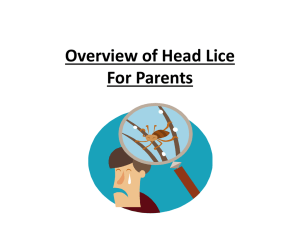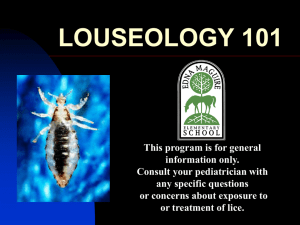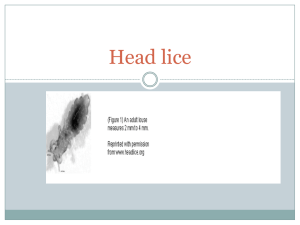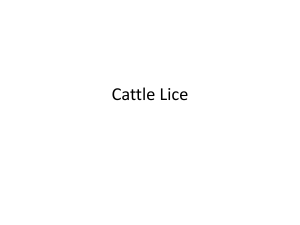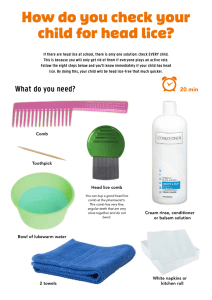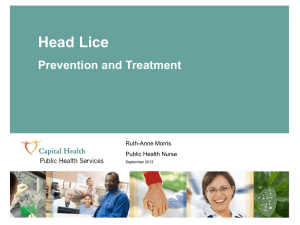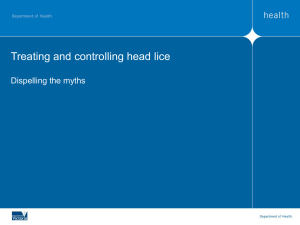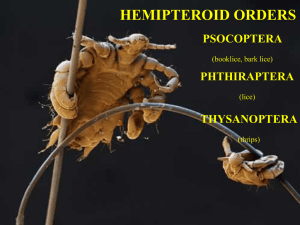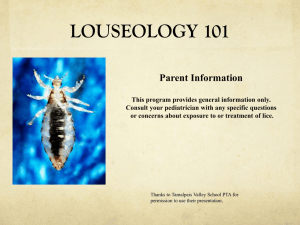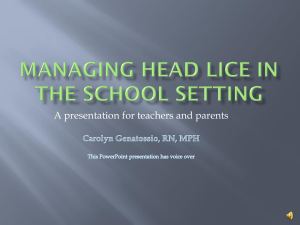Head Lice - Shoreline School District
advertisement
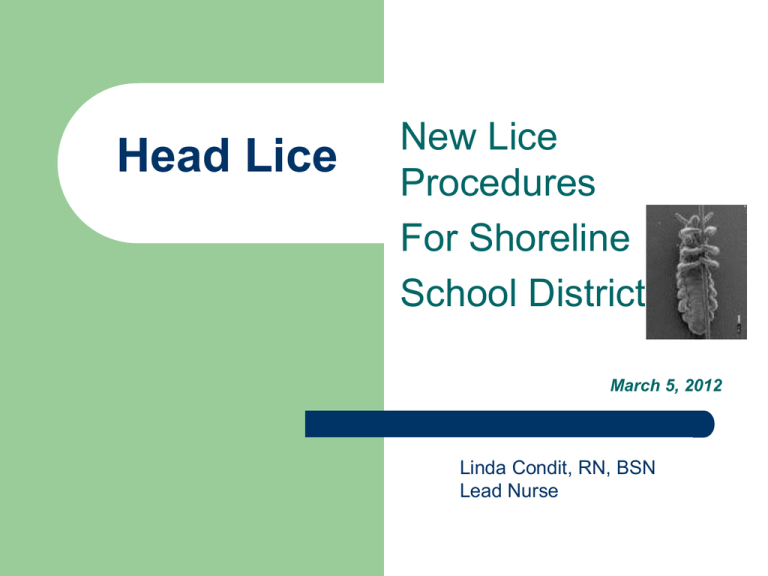
Head Lice New Lice Procedures For Shoreline School District March 5, 2012 Linda Condit, RN, BSN Lead Nurse Procedures for Schools are changing all over the country School policies for dealing with lice are outdated, based on myths and untruths rooted in unfounded fears of rampant outbreaks. The CDC, American Academy of Pediatrics, King County Health Dept, and National Association of School Nurses support updating policies to reflect current evidence based science. Objectives: After this presentation, school staff will: Identify facts about head lice Describe management of possible head lice infestation in the classroom according to newly designed Shoreline School District procedures Learn that our old ways of dealing with lice were exclusionary and placed unnecessary blame Recognize that lice are almost always present in schools in varying numbers Observe that science and evidence-based information on lice supports school districts in WA to adopt new policies Head Lice: Historical Perspective Lice likely co-evolved with people; claws are well adapted to grasping the human hair shaft. They don’t jump or fly. Lice are ‘host specific’ parasites. Human lice don’t live on dogs, cats or other animals. Lice must feed off scalp, so they die within 24-48 hours of separation from human hosts; if they have fallen off hair, they are at the end of the life cycle. Over use of pesticides have resulted in lice resistant to treatments. Being “nit-picky” relates directly to careful and complete removal of nits--- a helpful practice Head Lice: What are they? A head louse is an insect that lives on the human scalp and feeds on blood. Head lice hatch from a small eggs (nits) that are attached with a cement like substance to the shaft of individual hairs. Eggs hatch in about 10 days. Once hatched the head louse matures in less than 2 weeks. Female head lice may survive for as much as a month (most seem to perish sooner). Those more than about 2 weeks old increasingly become geriatric and tend to produce fewer eggs and less viable eggs. If nits are present, head lice have already been therebut may be long gone. Head Lice: How bad are they? Head lice do not transmit disease. Most louse infestations cause little, if any, direct harm. Annoying itching is a child’s usual complaint. The greatest harm associated with head lice is from the well-intentioned, but misguided over use of neuro-toxic substances to eliminate the lice. Traditional pediculocides and alternative formulations or methods are frequently over-applied and successfully kill only some of the lice and nits. Anyone with lice/nits is just unlucky, not unclean. Lice don’t care about heads- they just need a warm head to live on….. Clean or in need of a shampoo. Head Lice: How do we get them? The most common means of transmission is through physical/direct (head to head) contact!! Indirect transmission is uncommon but may occur via shared brushes, hats, and hair accessories or pillows and sheets that have been in contact with an infested person. Rarely, through shared helmets –they don’t live on helmets or coats alone. Surprisingly, schools are not a common source of transmission. Homes, camps and sleepovers are the most common sources. Managing Presumed Head Louse Infestations in Schools When lice are present it is NOT necessary to: exclude or quarantine a person in the health office notify classmates parents bring insecticide treatments to the school environment (sprays etc) bag clothes, toys, etc. vacuum, boil or launder all linens restrict use of headphones, equipment (helmets) report to CPS in absence of other indicators initiate classroom or school wide screening What staff need to know in response Creating unnecessary panic in the school community is a disservice to students. We need to educate students, families, and ourselves based on fact and not fear. – Head lice should not interfere with students’ opportunities to learn and achieve in the classroom. – Research proves education does help decrease cases! Missing school puts a child at risk for failure. Children with live lice most likely have had them for a month or more, so immediate exclusion is not necessary. Shoreline School District Procedure School employees will refer students with itchy heads or questionable lice to the school nurse or designee (trained by the nurse). The school nurse or designee shall examine the student. True cases will be determined by looking closely through the hair and scalp for viable nits or live lice. If live (crawling) lice are found on the hair, the parent/guardian will be notified by the end of the day via phone, email, and/or a note sent home with the student and appropriate treatment begun by parent. Shoreline School District Procedure cont’d If nits only are found on the hair, the parent should comb out the nits, as nit removal is recommended and parents should re-inspect for live adult lice within 7-10 school days. Old non-viable nits confuse the diagnosis. In both cases the parent/guardian will be provided information on the biology of head lice, methods to eliminate infestation, and directions to examine household contacts for lice and nits. The students’ friends and contacts should be informed by the parent, if appropriate, to encourage them to check, treat and/or examine other students most likely to have had direct head-to-head contact with the affected student. Shoreline School District Procedure cont’d Nurses can provide support for parent treatment of lice by checking in with student and parent in the weeks after lice are found. Nurses may still occasionally exclude students with chronic cases and help parents to comply with treatment and removal. The nurse or designee shall provide in-service education to staff. Information about head lice shall be provided yearly to all parents/guardians in the student handbook. Staff shall attempt to maintain the privacy of students identified as having head lice. Students identified with lice are less likely to feel shame and embarrassment when they are allowed to stay in school. Resources NASN pediculosis position statement http://www.nasn.org/Default.aspx?tabid=237 AAP policy on head lice http://aappolicy.aappublications.org/cgi/reprint/pediat rics;126/2/392 http://www.kingcounty.gov/healthservices/health/com municable/diseases/headlice.aspx http://www.cdc.gov/parasites/lice/head/schools.html
